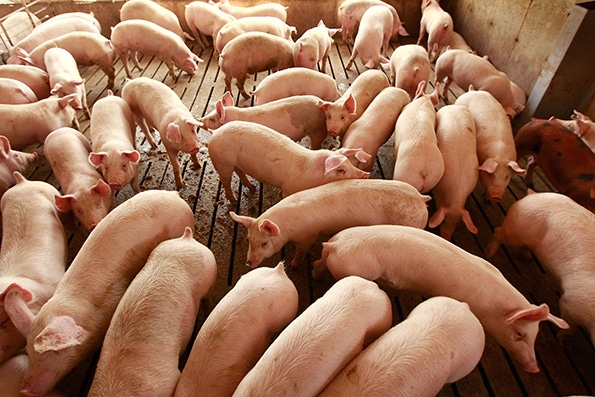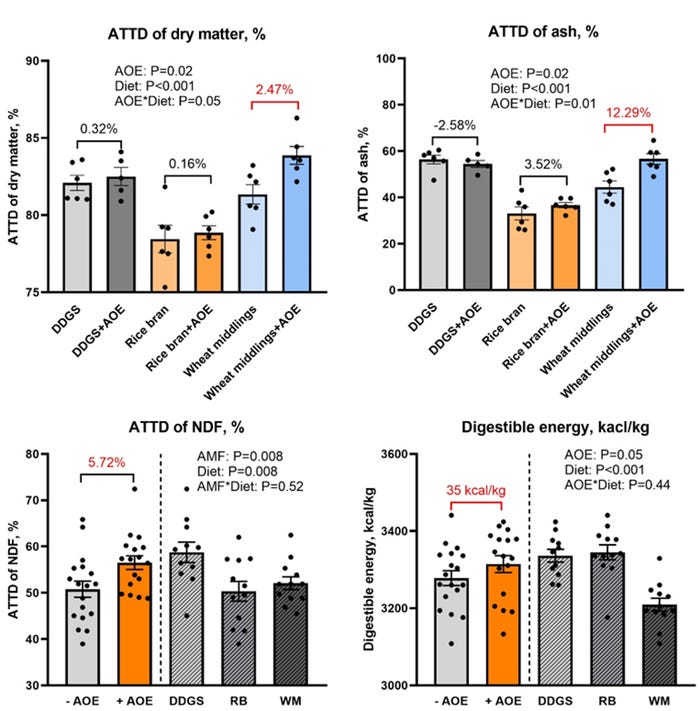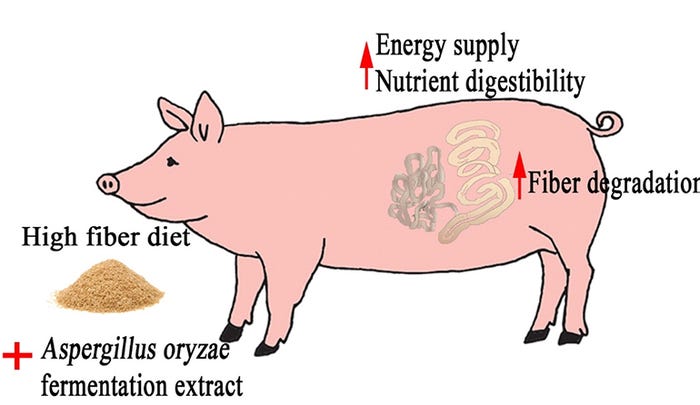Aspergillus oryzae extract supplement increases nutrient digestibility
Study indicates supplementation of Aspergillus oryzae fermentation increased total tract digestibility of gross energy, dry matter, neutral detergent fiber, crude protein and minerals.
October 10, 2019

By Jinlong Zhu, Jerry Shurson and Pedro E. Urriola, University of Minnesota; Lynsey Whitacre, BioZyme Inc.; and Ignacio Ipharraguerre, University of Kiel, Germany
Feed accounts for approximately 60% to 70% of the total cost of pork production in modern intensive systems and co-products of bio-fuel and food industry have been used to reduce feed cost (Stein and Shurson, 2009). However, most of the co-products have relatively high contents of dietary fibers, which are difficult to degrade by monogastric animals.
Negative impacts have often been reported when including high-fiber ingredients in pig diets because monogastric animals do not produce enzymes that can degrade dietary fiber and degradation by bacteria in the large intestine of monogastrics is relatively less compared with ruminants. Pre-treatment of corn fiber with ammonia fiber expansion can increase digestible energy by 400 kilocalories per kilogram in distillers dried grains with solubles (Urriola et al. 2019). However, this process is costly and difficult to apply at a large scale. Aspergillus oryzae fermentation extract (BioZyme Inc., St. Joseph, Mo.) has been used as a feed additive in ruminant diets to increase fiber degradation, increase nutrient digestibility, milk production and/or increased daily weight gain.
Research on application of AOE in sows reported an increased number of viable pigs and heavier litter of piglets at weaning (Moeller and Hess, 2016). However, there are no studies that have been conducted to determine effects of AOE on nutrient digestibility of pigs. Therefore, the objective of this research was to determine the effects of AOE on nutrient digestibility in growing pigs fed high-fiber diets. The trial was conducted with 18 growing barrows (initial body weight of 50.60 ± 4.90 kilograms) in two successive periods at the University of Minnesota Southern Research and Outreach Center in Waseca during January and March of 2019. Pigs were surgically equipped with a T-cannula at the distal ileum to collect ileal digesta. After a recovery period, pigs were allotted randomly to one of six corn and soybean meal-based diets that contained fiber containing feed ingredients to similar diet fiber level.

All diets were formulated to meet nutrient requirements for 50- to 75-kilogram growing pigs (National Research Council, 2012). Each experimental period lasted for 25 days and pigs were allowed 21 days to adapt to the diet. On Days 22 and 23, feces samples were collected to determine apparent total tract digestibility and on Days 24 and 25, ileal digesta were collected to determine apparent ileal digestibility. Standardized ileal digestibility of amino acids was calculated by correcting AID with basal endogenous amino acid losses from the same set of pigs.
Results from the study indicate that supplementation of 0.05% AOE increased (P < 0.05) ATTD of dry matter, gross energy, crude protein, NDF and ash. There were interactions between basal diet and AOE in which greater improvements were observed in pigs fed wheat middling diets. Total tract digestible energy was 35 kilocalories per kilogram greater (P < 0.05) in AOE groups than groups without AOE. Pigs fed the DDGS-plus-AOE diet had greater (P < 0.05) AID of ether extract compared with those fed DDGS diet. Supplementation of AOE did not (P > 0.05) affect AID of gross energy, dry matter, crude protein, NDF, ash or the SID of 18 amino acids and total amino acid.

Results of digestibility from this study indicate AOE could be a potential new strategy to improve utilization efficiency of high-fiber ingredients. A study from Zeng et al. (2018) also observed that exogenous non-starch polysaccharide degrading enzymes increased in vitro and in vivo digestibility of dry matter and gross energy in wheat middling but not in corn DDGS. Therefore, it appears that degradation of dietary fiber in corn DDGS is of greater difficulty than in wheat middling by either direct action of exogenous non-starch polysaccharide degrading enzymes or the indirect action of large intestine microbes with the use of AOE.

Conclusions and future directions
Supplementation with AOE increased total tract energy value and nutrient digestibility and AID of ether extract of high-fiber diets in pigs, which is a potential strategy to improve utilization efficiency of high-fiber feed ingredients. Application of AOE in swine diets shows the potential to help swine producers achieve profits in their operations especially when cheaper high-fiber co-products are used. Further analyses of microbiome and metabolome to investigate the potential mechanisms of improvement in nutrient digestibility by inclusion of AOE in pigs are ongoing.
It is also worth mentioning, that dietary fiber from insoluble coproducts from wheat and oats improve growth performance and decrease post-weaning diarrhea of young pigs and that AOE may benefit nursery pigs. However, these effects have not been tested.
References
Kerr, B.J., and G.C. Shurson. 2013. Strategies to improve fiber utilization in swine. J. Anim. Sci. Biotech., 4(1), 11.
Moeller, S.J., and M.B. Hess. 2016. Influence of Amaferm Digest More on swine lactation performance. J. Anim. Sci :94, suppl_2: 40-41.
NRC. 2012. Nutrient requirements of swine. 11th rev. ed. Washington (DC): National Academic Press.
Stein, H.H. and G.C. Shurson. 2009. BOARD-INVITED REVIEW: The use and application of distillers dried grains with solubles in swine diets. J. Anim. Sci. 87:1292-1303.
Urriola, P.E.; Z.K. Zeng, J.C. Yang and G.C. Shurson. 2019. Strategies to modify fiber structure and increase digestible energy in corn distillers dried grains with solubles. A report to the National Pork Board. Accessed October, 2019.
Zeng, Z.K., J.L., Zhu, G.C., Shurson, C. Chen, and P.E. Urriola. 2018. Improvement of in vitro ileal dry matter digestibility by non-starch polysaccharide degrading enzymes and phytase is associated with decreased hindgut fermentation. Anim. Feed Sci. and Tech., 246:52-61.
Sources: Jinlong Zhu, Jerry Shurson, Pedro E. Urriola, Lynsey Whitacre and Ignacio Ipharraguerre, who are solely responsible for the information provided, and wholly own the information. Informa Business Media and all its subsidiaries are not responsible for any of the content contained in this information asset.
You May Also Like



